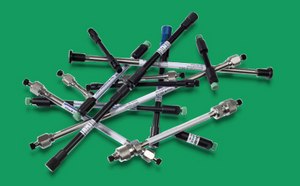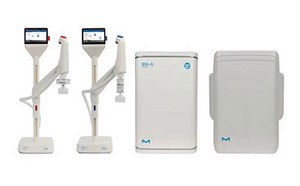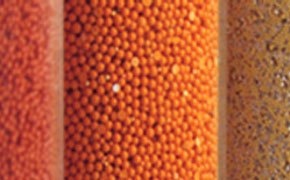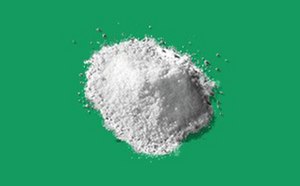Low Pressure Liquid Chromatography
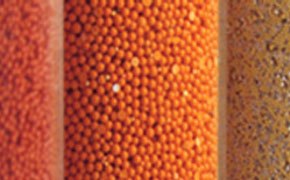
Low-pressure liquid chromatography (LPLC) is an analytical technique that uses low pressure to drive a mobile phase through a column containing a stationary phase, separating complex mixtures by differential partitioning. Originally performed with open columns that used gravity to move the sample through the packing bed, it is also known as "open column liquid chromatography. The different LPLC modes allow for the precise and efficient purification of compounds by separating them based on their chemical properties, such as size, charge, or affinity.
It is mostly used for studying biomolecules like proteins, peptides, and monoclonal antibodies due to its non-destructive preparative nature. Typically, LPLC makes it possible to keep the sample for further studies. LPLC offers additional benefits such as a simple design, strong siphon capabilities, and modest instrumentation requirements including detectors, low-pressure pumps, and fraction collectors. Its versatility makes it indispensable across pharmaceuticals, biotechnology, food and beverage, environmental monitoring, and research sectors. Moreover, by using lower pressures and using less solvent, LPLC complies with the principles of green chemistry.
Featured Categories
Achieve precise separations with our extensive HPLC column collection. Enhance retention, resolution, and selectivity.
Milli-Q® systems offer innovative water purification technologies engineered to...
Explore our LPLC product range: columns, adsorbents, resins, separation media, and accessories tailored to your unique application needs.
Choose the right HPLC grade buffers for precise reversed-phase chromatography. Explore our selection now.
Adsorption Chromatography
Also known as liquid-solid chromatography, adsorption chromatography retains chemicals by adsorbing and desorbing them at the surface of the support, stationary phase. The adsorbent forms the stationary phase, and the solute binds to it by van der Waal forces and steric interactions. Because adsorption sites are usually on the outer surface of the stationary phase, relatively tiny particles are used as the stationary phase. Silica, alumina, charcoal, Florisil, polyamides, celite, and diatomaceous Earth are the commonly used adsorbents.
Partition Chromatography
Partition chromatography separates by distributing the components between two immiscible liquids. One is the liquid mobile phase while other is the liquid held stationary on a solid support. Materials used a solid support include silica gel, diatomaceous earth, cellulose, polytetrafluoroethylene (PTFE), and polystyrene. The inert solid support provides a large surface area for the liquid stationary phase.
Affinity Chromatography
Affinity chromatography separates constituents by selective and reversible interactions, such as antibody-antigen, enzyme-substrate, or hormone-receptor pairs, with one of the interacting agents as the stationary phase. The "affinity ligand" is the interacting species immobilized on solid support such as acrylic beads, agarose, and Toyopearl resins, and it serves as the stationary phase for the affinity column.
Gel Filtration Chromatography
Also known as size exclusion chromatography, it separates molecules of different size such as proteins of varying sizes and oligomeric forms. The stationary phase is a resin made up of cross-linked matrix of beads containing pores of a specific size. Gel filtration columns contain beads of polyacrylamide, agarose, dextran, or a mix of any of these. It isolates smaller analytes by providing partial or full access to the pore volume within the column packing particles.
Hydrophobic Interaction Chromatography (HIC)
Hydrophobic interaction chromatography (HIC) separates biomolecules based on differences in their surface hydrophobicity. It is based on the interaction of non-polar hydrophobic groups linked to the column resin, such as butyl, octyl, or phenyl, with the hydrophobic groups on biomolecules. It is widely used to separate proteins while preserving their biological activity since it uses lesser denaturing conditions and matrices.
Ion Exchange Chromatography (IEX)
Ion exchange chromatography separates molecules based on differences in their net surface charges. The surface of the matrix, such as cellulose, silica, or styrene-divinylbenzene, is covalently linked to charged functional groups. The resin's immobilized ion exchange groups interact with molecules that have opposite charges. In cation exchange chromatography, positively charged species in the mobile phase bind to a negatively charged ion exchange resin. In anion exchange chromatography, negatively charged species in the mobile phase bind to the positive charges on the ion exchange resin.
Low-pressure Liquid Chromatography System
A low-pressure liquid chromatography (LPLC) system typically consists of a column filled with a stationary phase for separation, a pump to deliver the mobile phase through the column at controlled flow rates, and a detector to measure the eluent as it exits the column.
LPLC systems also feature an injection system for introducing the sample into the mobile phase stream, ensuring precise and reproducible sample introduction. Some setups include a fraction collector to gather separated components for further analysis.
Visit our document search for data sheets, certificates and technical documentation.
Related Articles
- This page describes the maintenance of media and storage conditions for multimodal chromatography using Cytiva products.
- Ultra-high performance liquid chromatographic (UHPLC) separation of ephedrine and its three structural analogs based on polar retention effect on graphite (PREG) mechanism using Supel™ Carbon LC column.
- UHPLC separation of Vitamin D Metabolites using Supel™ Carbon LC column ensures excellent peak shape and sensitivity.
- This page covers the standard ÄKTAdesign configurations for simple IEX chromatography.
- This page describes the difference between bind/elute and flowthrough modes in multimodal chromatography using Cytiva products.
- See All (38)
Related Protocols
- This page shows how to convert between linear flow and volumetric flow rates in affinity chromatography.
- The Amberlite™ XAD-4 resin used in Porozorb™ cartridges is a proven technology that is highly effective in removing various detergents from cell culture media for biopharmaceutical applications such as vaccine production.
- Separation using Sephadex LH-20 column for Size Exclusion Chromatography media in polysaccharide network from Cytiva.
- Superose from Cytiva are Size Exclusion Chromatography media consisting of a composite base matrix of dextran and agarose. This page shows how to perform a separation with a superose column.
- In this section the practical aspect of Reverse Phased Chromatography ( RPC) is discussed including media and column selection and eluent selection and preparation.
- See All (45)
Find More Articles and Protocols
How Can We Help
In case of any questions, please submit a customer support request
or talk to our customer service team:
Email custserv@sial.com
or call +1 (800) 244-1173
Additional Support
- Chromatogram Search
Use the Chromatogram Search to identify unknown compounds in your sample.
- Calculators & Apps
Web Toolbox - science research tools and resources for analytical chemistry, life science, chemical synthesis and materials science.
- Customer Support Request
Customer support including help with orders, products, accounts, and website technical issues.
- FAQ
Explore our Frequently Asked Questions for answers to commonly asked questions about our products and services.
To continue reading please sign in or create an account.
Don't Have An Account?